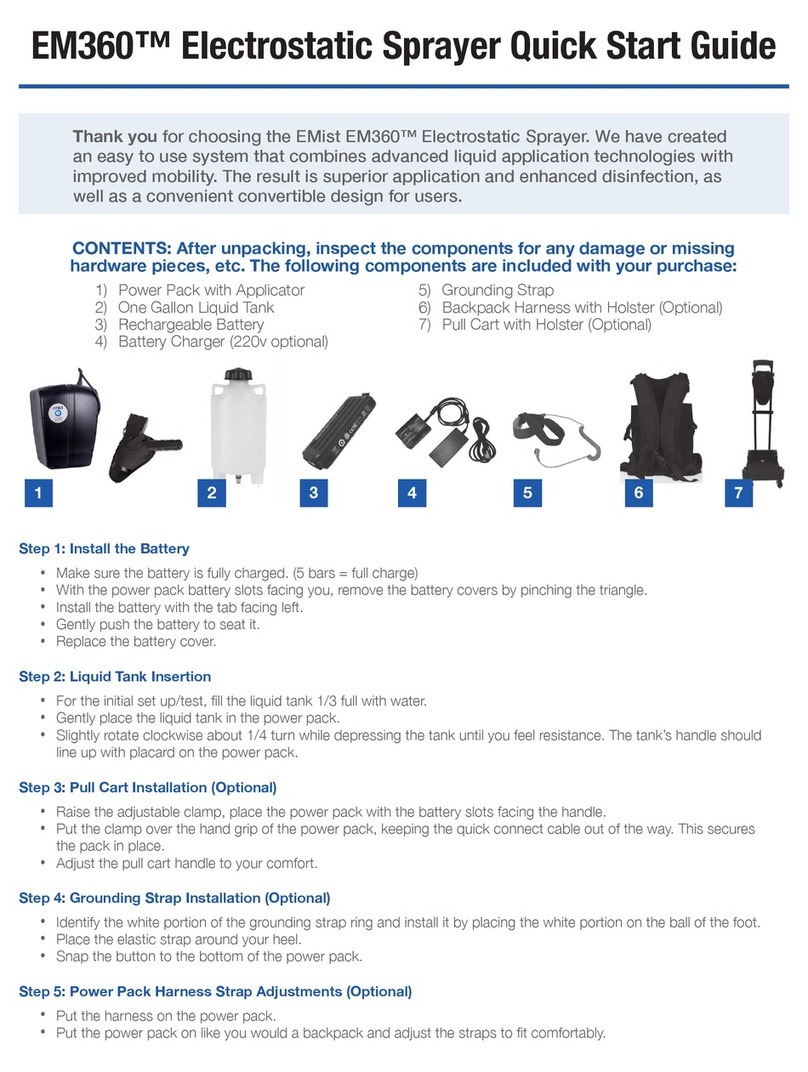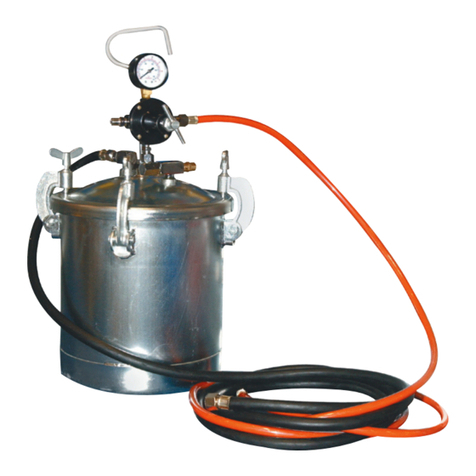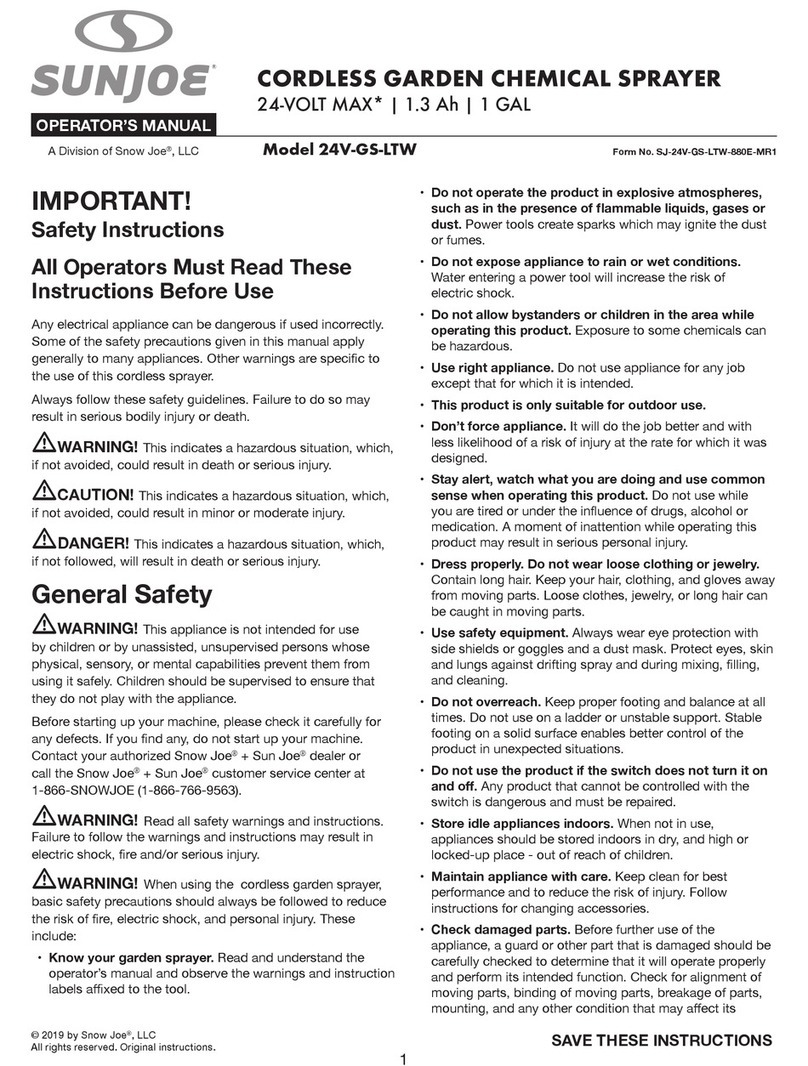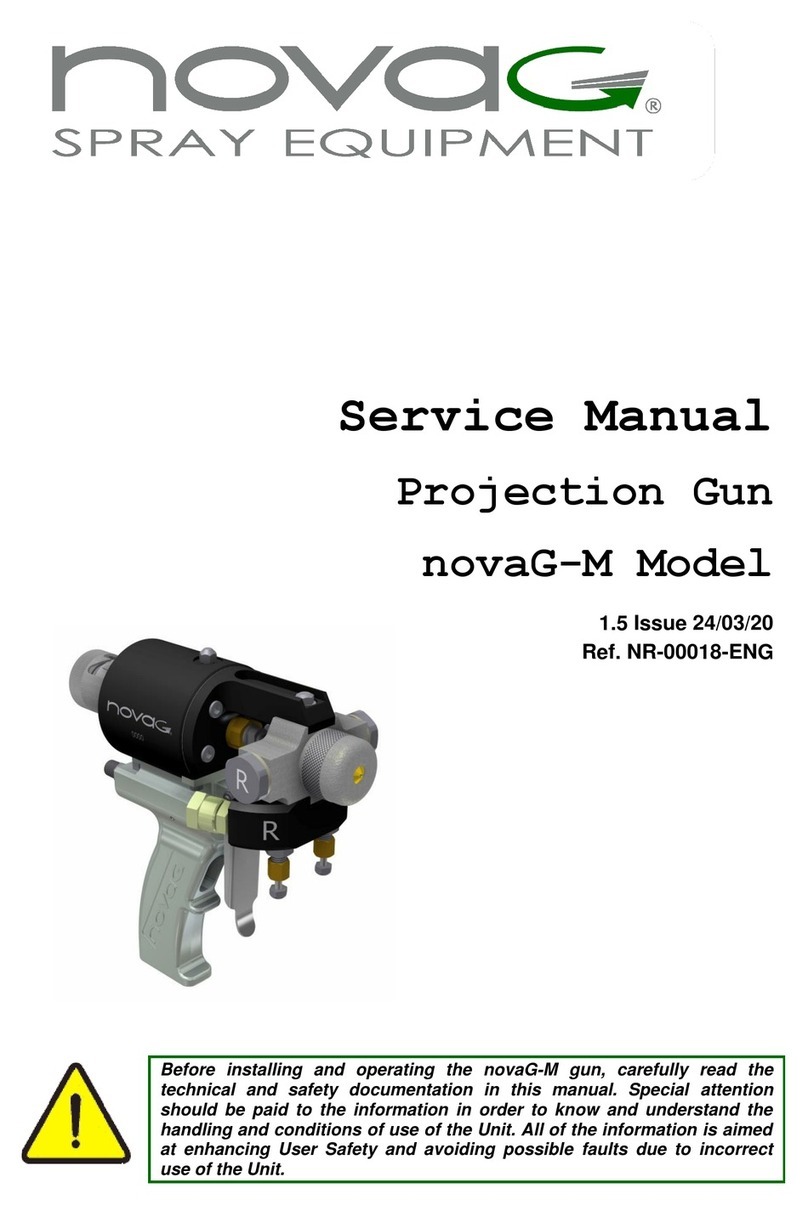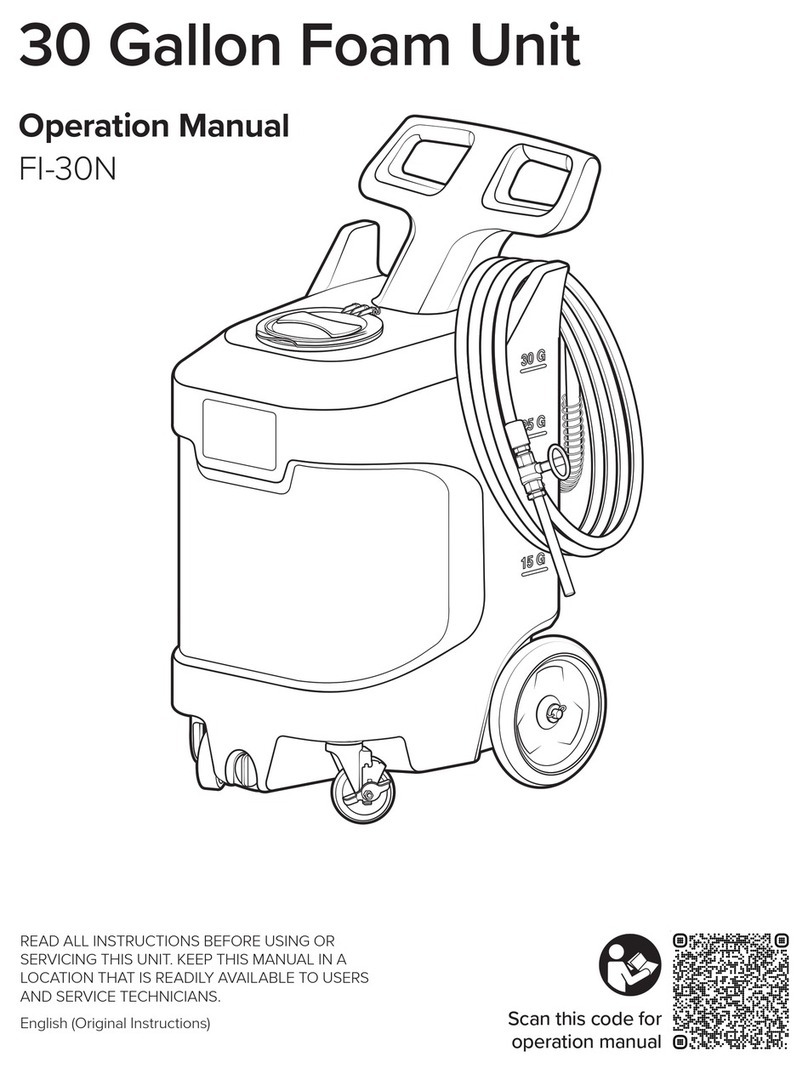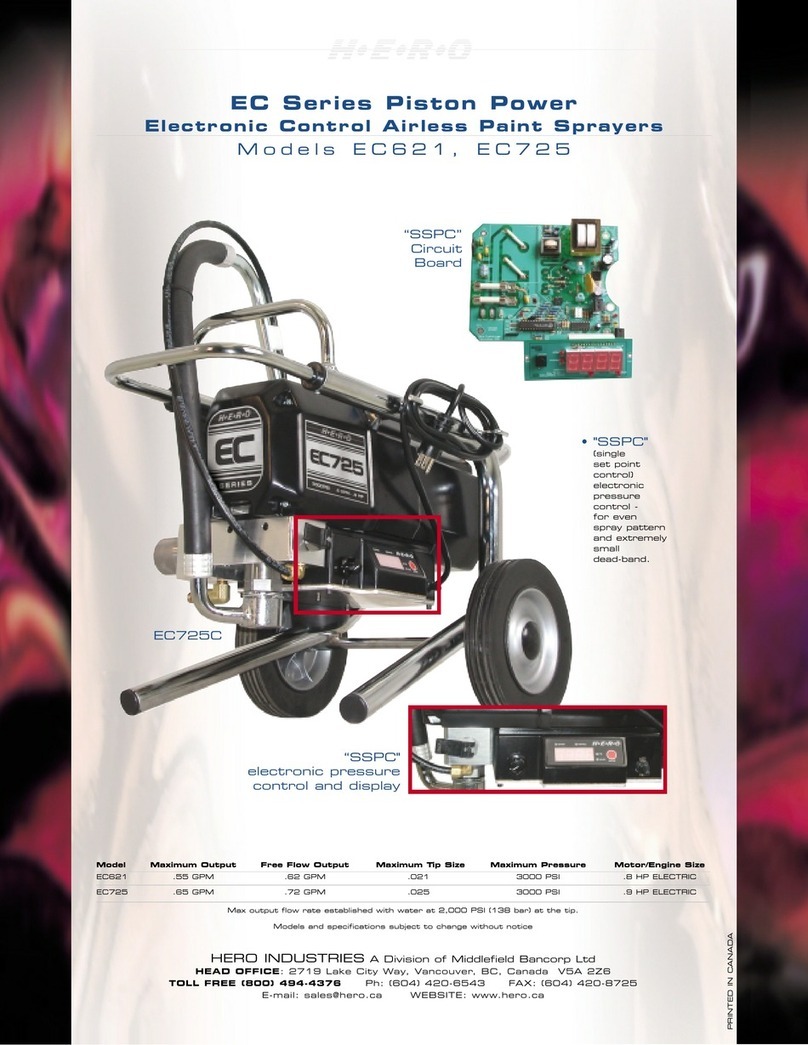aerosolv 6000 User manual

aerosolv
®6000
AEROSOL CAN RECYCLING

A
E
R
O
S
O
L
V
AEROSOLV.COM
MODEL 6000

TABLE OF CONTENTS
6000 INSTRUCTION MANUAL
2 Introduction to the Aerosolv® 6000 Recycling System
3 Safety Instructions
4 Aerosolv 6000 Unit Installation
5 Aerosol Can Puncturing Using the Aerosolv 6000 System
5 Aerosolv 6000 Filter
8 Aerosolv 6000 Maintenance
10 Mile Marker Chart & Drum Capacity Determination
11 Table 1-1: Sample Aerosol Can Segregation Scheme
12 Table 1-2: Recommended Aerosol Product Consolidation
Scheme
14 Table 1-3: Aerosol Consolidation Classes
15 Table 1-4: Aerosol Class Compatibility Chart
15 Table 1-5: Aerosol Class Consolidation Chart

The Aerosolv 6000 Aerosol Can Recycling System simplifies
aerosol can disposal, safely and eciently. The puncturing unit
threads directly to the 2” bung of any 30-gallon or 55-gallon drum.
Simply insert an inverted aerosol can into the Aerosolv® unit and
lock the sliding top plate. With a press of the handle, a specially
designed puncture pin pierces the dome of the can. The contents
are dispersed down and directly into the receiving drum; the partic-
ulate laden propellant is coalesced in the first stage of the Aerosolv
3601 high eciency combination filter providing propellant flow to
the carbon cartridge. What’s left is an aerosol can that is fully recy-
clable; eliminating an entire waste stream.
The result? Recyclable scrap steel.
After processing aerosol cans with the Aerosolv system, you’ve got
an empty steel can with a small, smooth-edged hole. No spills. No
jagged edges. And, no compressed gas, so it’s ready for recycling
with other scrap steel.
INTRODUCTION TO THE AEROSOLV 6000
AEROSOL CAN RECYCLING SYSTEM

SAFETY INSTRUCTIONS
1. Wear safety goggles while operating the Aerosolv® system.
2. DO NOT use Aerosolv while smoking or near open flame.
3. Install anti-static wire to properly “ground” drum.
4. DO NOT use Aerosolv on a drum with less than 30-gallon
capacity.
5. Remove Aerosolv to an empty drum once collection drum is 70%
full (when contents reach within 10” of the top).
6. Always engage sliding top plate and sealing knob against can
being punctured.
7. Always operate the Aerosolv system outdoors or in a well
ventilated area. Propellant is heavier than air and may collect at
point of generation.
8. Do not use the Aerosolv unit for pesticides, herbicides,
adhesives, or corrosive materials with pHs less than 2.0 or greater
than 12.5 (i.e., Easy-O®, corrosive acidic, and alkaline products).
Comingling incompatible can contents can be hazardous. Operator
must develop a segregation scheme to ensure safe operation and
liquid collection.
9. Process like aerosol cans to the same collection drum for
recycling (e.g., paints with paints, cleaners & degreasers with same)
10. Tip: Avoid puncturing aerosol cans of cold galvanizing
compound or insulation foam, unless can is empty.

.
Thread the aluminum filter base with the attached
activated carbon filter carbon filter into the 3/4” bung
of the liquid collection drum - your system setup is now
complete.
AEROSOLV 6000 UNIT INSTALLATION
Obtain a 30 or 55-gallon liquid collection drum, poly or
steel, possessing two standard bungholes: one large 2”
bung; and one small 3/4” bung. Select a receptacle that
is compatible with the aerosol product to be captured
and inspect the receptacle for deterioration or signs of
breached integrity. Ensure the bung caps for each hole
are in place. Remove the bung caps and store them in a
safe place so that they may be used later.
Thread the Aerosolv® unit into the 2” bung. Rotate
clockwise until ground support plate firmly engages
drum rim.
Attach ring terminal of anti-
static wire to the brass screw on
Aerosolv ground support plate.
See inset. Secure alligator clip
to any nearby confirmed ground
source. Electrical grounding must
comply with the applicable state
and federal regulations.

USING THE AEROSOLV® 6000 SYSTEM
AEROSOLV 6000 FILTER
• Wear safety goggles while operating Aerosolv
• Insert aerosol can, NOZZLE END DOWN, into Aerosolv housing
sleeve, so that shoulder of can rests on gasket. Be sure to remove
cap from aerosol can prior to insertion.
• When puncturing oversized “jumbo” cans, remove white poly
sleeve from Aerosolv housing, then insert can as above.
• Lower sliding top plate and FIRMLY engage the cap compression
knob against bottom of can. Twist cap copression knob to adjust.
TIGHTEN lock knob on slide bar.
• Push handle down firmly until completely
depressed and hold in place while can
releases initial pressure. See inset. Slowly
raise the handle and immediately depress,
this will control the rate of pressure and
content evacuation from the aerosol can.
In order to prevent back pressure, allow
the contents of the can to drain into the
collection drum (about 20 seconds).
Tip: Prevent vapors from escaping through 2” bung opening by
leaving the last can punctured in the puncturing device.
When venting an aerosol can the activated carbon will generate
heat as the granular carbon adsorbs the hydrocarbons. Typically
20-25 degrees above ambient temperature. This will activate
the liquid crystal indicator to signal adsorption of VOC’s and will
light ‘RED’ during the adsorption process. Returning to black
when the adsorption process is complete.
ADSORPTION INDICATOR

Remove the weather cap and
place on drum. There is no need
to remove the upper filter housing
from the lower filter housing
during this process. See Figure 1.
Remove the activated carbon
filter insert. See Figure 2. Set the
used filter aside to be disposed
of in accordance to local, state,
and federal laws. Check with local
authorities having jursidiction.
FILTER MAINTENANCE
• Replace the activated carbon filter
insert (inside upper portion) and the
coalesceing filter with pull tab (inside
lower housing) every 1000 cans or
when the adsorption indicator no
longer appears ‘RED’ when venting
aerosol cans. More frequent change-outs may be necessary based
on use and volume of the cans processed. (Aerosol cans with 25%
or less content may not activate indicator.)
• To replace simply order Part #3602 – Filter Replacement Kit, which
includes 2 internal coalescers and 2 activated carbon filter inserts.
See Mile Marker Chart for maintenance schedule.
HOW TO CHANGE OUT YOUR
FILTER COMPONENTS
Pull Tab

Remove the internal coalescer
using the pull tab from the
aluminum base. See Figure 3.
Visually inspect the base for any
standing liquids. If liquid has
collected in the base drain the
contents following the instructions
provided on the green lower filter
housing label.
Reassemble your filter starting with
the internal coalescer making sure
you get a snug fit in the aluminum
base. See Figure 4. Insert a new
activated carbon filter, make sure
you remove it from the shrink wrap
and align the sight window with the
adsorption indictor. See Figure 5.
Finally, twist your weather cap back
into place. See Figure 6.
•To restock order Part #3602 – Filter Replacement Kit
• Periodically check and empty the collected liquid content in the filter
base if needed. To empty, remove the carbon filter housing from the
aluminum filter base.
• Unscrew the filter base from the drum and carefully drain the collected
liquids through the AEROSOLV housing directly into the drum.

MAINTENANCE
AEROSOLV ANTI-STATIC WIRE
AEROSOLV MAINTENANCE
COMPLIANCE
OSHA requires that liquid storage vessels be
grounded to prevent static electricity build-up.
The Aerosolv System includes an anti-static
wire for user convenience.
By bringing the propellant to atmospheric pressure, Aerosolv
achieves compliance with:
› 40 CFR 261.7(b)(1)
› 40 CFR 261.7(b)(1)(B)(2)
› 40 CFR 261.23(a)(6)
Periodic cleaning and greasing of the puncture pin will assure years
of use. With constant, heavy usage, the puncture pin should be
cleaned and greased once a month.
• To clean or replace puncture pin, remove bridge pin at
uppermost point of handle. Entire handle mechanism and
puncture pin can be removed.
Gasket deterioration will occur when venting aerosol paints and
aggressive solvents, requiring periodic gasket replacement. To
assure proper seal during Aerosolv usage, check gaskets frequently
and replace as required.
• To replace gasket, remove white plastic sleeve from Aerosolv
housing, then simply pull out old gasket and snap in replacement.

REPLACEMENT ACCESORIES FOR #6000
#6000 AEROSOLV CAN RECYCLING SYSTEM
RECYCLING
Once relieved of pressure, aerosol cans are not regulated waste
(OSWER Directive 9432.01 (80)). In addition, puncturing aerosol cans
to achieve atmospheric pressure is not considered “treatment”;
therefore, permitting is not required.
• Recycling 8,000 aerosol cans reduces solid waste and
increases recycling by one ton.
• By installing Aerosolv® systems on two drums, non-chlorinated
aerosols can be collected separately, then reclaimed as
solvents, resulting in waste minimization credits.
• Cans punctured using Aerosolv may be recycled with other
scrap steel.
Aerosolv leaves only a smooth edged hole.
• Puncturing unit with built in
safety shield slide bar
• Anti-static wire
• Safety goggles
• #3601 High eciency
combination carbon filter
with extreme duty aluminum
filter base
Maintenance repair kit: includes puncture pin with o-rings,
aeroprene gasket, bridge pins, spring and tube of grease
Replacement carbon cartridge for combination filter with flashback
inhibitor (pkg of 2), high eciency proprietary polymer coalescer (pkg of 2)
Aeroprene gasket
Model #3602
Model #5165EX
Model #5129

MILE MARKER CHART
DRUM CAPACITY DETERMINATION
1000
2000
3000
4000
4500
Replace Activated Carbon Cartridge and internal coalescer
Replace Activated Carbon Cartridge and internal coalescer —
check aluminum filter base for collected liquids
Replace Activated Carbon Cartridge and internal coalescer —
check aluminum filter base for collected liquids
At this point a 55 gallon drum should be 75–80% full and
ready for handling. Reset the counter. Mount the Aerosolv
6000 system and new combination filter onto an empty
drum. Depending on wear, replace housing o-ring, clean out
the system including the filter base, reapply PTFE tape to the
threads, and lubricate the rack gear.
Replace Activated Carbon Cartridge and internal coalescer
CAN COUNT ROUTINE MAINTENANCE & FILTER CHANGES
The volume of liquid accumulating in the liquid collection drum should be
noted prior to commencing operations. Procedures for determining when
the collection receptacle is full are as follows:
1. Using the drum level indicator provided with your system follow steps 2 through 6.
2. Remove the weather cap and place on drum. There is no need to remove the upper filter
housing from the lower filter housing during this process.
3. Remove the activated carbon filter insert as well as the internal coalescer using the pull
tab from the aluminum base.
4. Carefully drop the drum level indicator into the filter hosing through the hole that is now
visible allowing disc to rest on the filter housing.
5. Slowly raise the tool and inspect it to determine whether liquid has reach the end of
the rod.
6. If the liquid level in the collection container actually reached the end of the rod when
submerged, secure the container, wipe o the tool using the rag, and call for pick
up. If the liquid level has not yet reached the ruler, continue to puncture aerosol cans
in accordance with the Aerosolv 6000 manufacturer’s operation and maintenance
instructions. Repeat steps 2 through 6 to check the liquid level every 500 cans.

AEROSOL TYPES COMMON EXAMPLES
1- Ignitable solvent product w/flammable
propellant
Prestone® Starting Fluid, Keen Limited® Zeus®
Butane, Malter® Dimethylsilicone Lubricant
Compound, Liquid Wrench®, WD-407
2- Hydrocarbon product w/flammable
propellant
OMC® Anticorrosion Spray, Sprayon® Gear Lube,
Panef® Lubricant with Teflon®, Zep® Cutting Oil,
Solid Film Lubricant, Penetrating Fluid
3- Halocarbon product w/flammable
propellant
Freon 114, Degreaser
4- Halocarbon product w/nonflammable
propellanti
Dichlorotetrafluoroethane, Freon 113, Berryman®
Brake Cleaner
5- Hydrocarbon product w/ nonflammable
propellant
Nut Buster® Penetrating Oil, Corrosion Preventative
Compound, General Purpose Lubricating Oil
6- Toxic constituent containing product w/
flammable propellant
Enforcer® Wasp and Hornet Killer, D-trans Allethrin
7- Toxic constituent containing product w/
nonflammable propellant
PT 270 Dursban®, PT 515 Wasp Freeze®, PT-240
Perma Dust®, PT-279 Engage7
8- Corrosive product with flammable
propellant: 8A: Acidic Product
8B: Alkaline Producti
Easy O® Oven Cleaner, Degreaser
9- Corrosive product with nonflammable
propellant: 9A: Acidic Product
9B: Alkaline Product
Oven Cleaner, Degreaser
10- Non-toxic product with flammable
propellant
Lemon Pledge®, Glade® Air Freshener, Pam®
Coating
11- Listed product with flammable
propellant
Block Cleaner, Hi-Tech Safety Solvent® 1,1,1-
trichloroethane, Sprayon® 1,1,1- trichloroethane
12- Listed product with nonflammable
propellant
Bulk Chemical® 1,1,1-trichloroethane technical, Plaze
Inc.® 1,1,1-trichloroethane technical
13- Paints with flammable propellants Krylon®, Pittsburgh®
14- Adhesives with flammable propellants Super 7® Adhesive Spray®,
99MA High Tack Spray-AGasket 800657
TABLE 1-1
SAMPLE AEROSOL CAN SEGRAGATION SCHEME

CONSOLIDATION
FAMILY
AEROSOL TYPES
INCLUDED IN FAMILY
RATIONALE FOR
CONSOLIDATING TYPES
1- POL: Petroleum, Oil,
and Lubricants
(2) Hydrocarbon product/
flammable propellant
(15) Hydrocarbon product/
nonflammable propellant
Recovered POL can be recycled and used for
fuel blending. Propellants captured from POL
aerosol cans are adsorbed on the activated
carbon filter. Saturated activated carbon
cartridges are properly disposed of as nonreg-
ulated refuse.
2- Paints (13) Compatible paints Paints are recovered and stored in appropriate
containers. Recovered paints are managed
as hazardous wastes and either recycled or
transferred to an appropriate treatment facility.
Propellants captured from paint aerosol cans
are adsorbed on the activated carbon filter.
Saturated activated carbon cartridges are
properly disposed of as non-regulated refuse.
3- Adhesives (14) Compatible adhesives Adhesives are recovered and stored in
compliant containers. Recovered adhesives
are managed as hazardous waste and either
recycled or transferred to an appropriate
treatment facility. Propellants captured from
adhesive aerosol cans are adsorbed on the
activated carbon filter. Saturated activated
carbon cartridges are properly disposed of as
non-regulated refuse.
4- Compatible Alka-
line Cleaners
(8B) Corrosive product/
flammable propellant
(9B) Corrosive product/
nonflammable propellant
If compatible, aqueous alkaline products from
aerosol cans are recovered and consolidated
with similar products. These materials can be
transferred to an appropriate treatment facility.
Propellants captured from these aerosol cans
are adsorbed on the activated carbon filter.
Saturated activated carbon cartridges are
properly disposed of as nonregulated refuse.
5- Compatible Acidic
Cleaners
(8A) Corrosive product/
flammable propellant
(9A) Corrosive product/
nonflammable propellant
If compatible, aqueous acidic products from
aerosol cans are recovered and consolidated
with similar products. These materials can be
transferred to an appropriate treatment facility.
Propellants captured from these aerosol cans
are adsorbed on the activated carbon filter.
Saturated activated carbon cartridges are
properly disposed of as nonregulated refuse.
TABLE 1-2
RECOMMENDED AEROSOL PRODUCT
CONSOLIDATION SCHEME

CONSOLIDATION
FAMILY
AEROSOL TYPES
INCLUDED IN FAMILY
RATIONALE FOR
CONSOLIDATING TYPES
6- Halocarbon
Solvent
(3) Halocarbon product/
flammable propellant
(4) Halocarbon product/
nonflammable propellant
Recovered halocarbon solvents may be
distilled and reutilized or transferred to an
appropriate treatment facility. Propellants
captured from halocarbon aerosol cans
are adsorbed on the activated carbon filter.
Saturated activated carbon cartridges
areproperly disposed of as non-regulated
refuse.
7- Ignitable Solvents (1) Ignitable solvent product/
flammable propellant
Recovered ignitable solvents may be
distilled and reutilized, recycled as fuel, or
transferred to an appropriate treatment facility.
Propellants captured from these aerosol cans
are adsorbed on the activated carbon filter.
Saturated activated carbon cartridges are
properly disposed of as non-regulated refuse.
8- Listed Products 11) Listed product/
flammable propellant
(12) Listed product/
nonflammable propellant
Listed products may be distilled and reutilized,
recycled, or collected in isolated vessels
and managed as listed hazardous wastes.
Propellants captured from these aerosol cans
are adsorbed on the activatedcarbon filter.
Saturated activated carboncartridges are
properly disposed of as non-regulated refuse.
9- Toxic Products (6) Toxic product/
flammable propellant
(7) Toxic product/
nonflammable propellant
Toxic products are either recycled or managed
as hazardous waste and transferred to an
appropriate treatment facility. Propellants
captured from these aerosol cans are
adsorbed on the activated carbon filter.
Saturated activated carbon cartridges are
properly disposed of as non-regulated refuse.
10- Non-Toxic
Products
(10) Non-toxic product/
flammable propellant
Non-toxic products are managed appropriately.
Propellants captured from these aerosol cans
are adsorbed on the activated carbon filter.
Saturated activated carbon cartridges are
properly disposed of as non-regulated refuse.
TABLE 1-2 (CONT’D)
RECOMMENDED AEROSOL PRODUCT
CONSOLIDATION SCHEME

CONSOLIDATION
FAMILY
AEROSOL TYPES
INCLUDED IN FAMILY
RATIONALE FOR
CONSOLIDATING TYPES
1- Petroleum
Hydrocarbons (non-
halogenated)
(1) POL
(2) Paints1
(7) Ignitable Solvents
(8) Listed Products2
(9) Toxic Products3
(10) Non-Toxic Products3
See Footnotes 1, 2, and 3
2- Resinous Materials (3) Adhesives Adhesives and other resinous coagulating
materials tend to diminish the quality of
otherwise recyclable solvent products. Further,
these products accelerate the deterioration of
process equipment.
3- Aqueous Liquids (4) Alkaline Cleaners4
(5) Acidic Products4
(9) Toxic Products5
(10) Non-Toxic Products5
See Footnotes 4 and 5
4- Halocarbon
Solvents
(6) Halocarbon Solvents Many petroleum products cannot be recycled
when contaminated with halocarbons. Though,
halocarbon solvents are compatible with
and can typically be commingled with other
petroleum products and solvents.
5- Alkaline Products (4) Corrosive Alkaline Products Alkaline products potentially
present a threat of heat generation through
acid-base or oxidation-reduction reactions.
1 Paints may either be consolidated separately or consolidated with other petroleum and petroleum-based products.
If the resulting waste is going to be incinerated or fuel blended (provided the paint solids do not compromise the
quality of the mixture), the paints may be consolidated with other products. If the resulting waste is to be recycled or
otherwise utilized, the paint should be managed independently.
2Listed petroleum and petroleum-based wastes may be commingled with other petroleum products if the resulting
mixture is characterized in accordance with the Mixture and Derived from Rules (40 CFR, ‘261.3), and if the mixture
will be either incinerated or fuel blended. Listed wastes may not be commingled with other wastes if the resulting
mixture is not characterized and managed as a listed hazardous waste.
3Toxic and non-toxic petroleum products may be commingled with other petroleum products unless the resulting
mixture is intended for specific recycling or reuse eorts and the addition of these products significantly diminishes
the quality of the final product. Non-petroleum products may not be commingled with petroleum products.
4Aqueous acidic and alkaline products whose pH remains between 4.0 and 10.0 may be commingled as long as the
constituents that comprise the solutions are compatible. Products exhibiting pHs significantly greater than 10.0 or less
than 4.0 should not be commingled. Additionally, non-aqueous solutions should not be commingled with aqueous
solutions.
5Aqueous toxic and non-toxic products may be commingled with other aqueous wastes provided the constituents that
comprise the products are compatible with each other. The characterization of the resulting mixture must be similar to
that of the products prior to introduction.
TABLE 1-3
AEROSOL CONSOLIDATION CLASSES

petroleum
hydrocarbons
resinous
materials
aqueous
liquids
halocarbon
solvents
alkaline
products
acidic
product
petroleum hydrocarbons yes yes6yes7yes6no8no8
resinous materials yes6yes no9yes no no
aqueous liquids yes7no9yes yes10 yes yes
halocarbon solvents yes6yes yes10 yes no11 no11
alkaline products no8no yes no11 yes no
acidic product no8no yes no11 no yes
petroleum
hydrocarbons
resinous
materials
aqueous
liquids
halocarbon
solvents
alkaline
products
acidic
product
petroleum hydrocarbons yes no no no no no
resinous materials no yes no no no no
aqueous liquids no no yes no no no
halocarbon solvents no no no yes no no
alkaline products no no no no yes no
acidic product no no no no no yes
6 Refer to recommended consolidation chart.
7Petroleum hydrocarbons are compatible with but not typically soluble in aqueous liquids. Refer to recommended
consolidation chart.
8Petroleum hydrocarbons and corrosive materials are typically compatible. However, some corrosive matrials
are incompatible with petroleum hydrocarbons. As such, for purposes of simplicity, this chart recommends not
commingling the two.
9Some resinous materials react adversely with water. This chart reflects conservative management.
10 Halocarbons are compatible with but not typically soluble in aqueous liquids. Refer to recommended
consolidation chart.
11 Halocarbon solvents and corrosive materials are typically compatible. However, some corrosive materials are
incompatible with halocarbons. As such, for purposes of simplicity, this chart recommends not commingling the two.
TABLE 1-4
TABLE 1-5
AEROSOL CLASS COMPATIBILITY CHART
AEROSOL CLASS CONSOLIDATION CHART

MAINTENANCE LOG
DATE NAME MAINTENANCE PERFORMED

NOTES

RMP6001 Rev A ©2017 Aerosolv Incorporated. U.S. and other patents pending.
aerosolv.com
aerosolv AEROSOL
CAN RECYCLING
®
888-818-7114
RMP6001 RevB- ©2018 Aerosolv Incorporated US Patents: 9,845,232 and 9,827,528.
Popular Paint Sprayer manuals by other brands

Central Pneumatic
Central Pneumatic 47016 67181 Owner's manual & safety instructions

Garten Meister
Garten Meister GM AS 8 LI Original instructions

Glas Craft
Glas Craft LPA2-100G Operation manuals
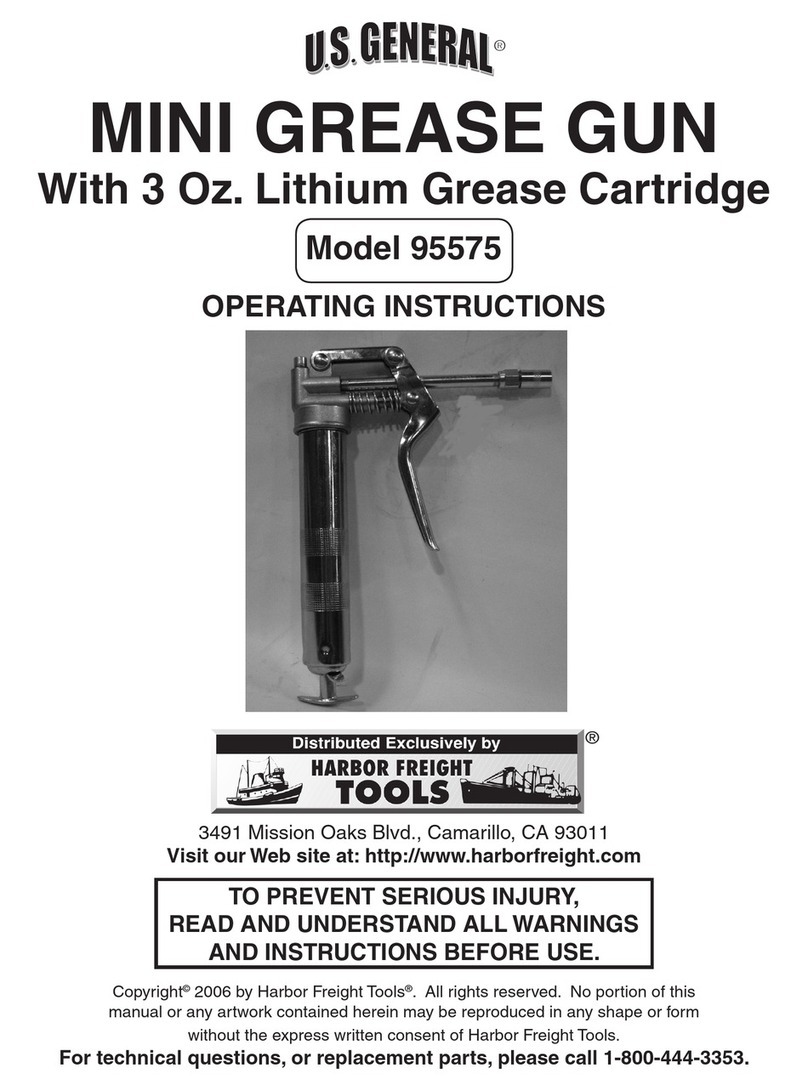
U.S. General
U.S. General 95575 operating instructions
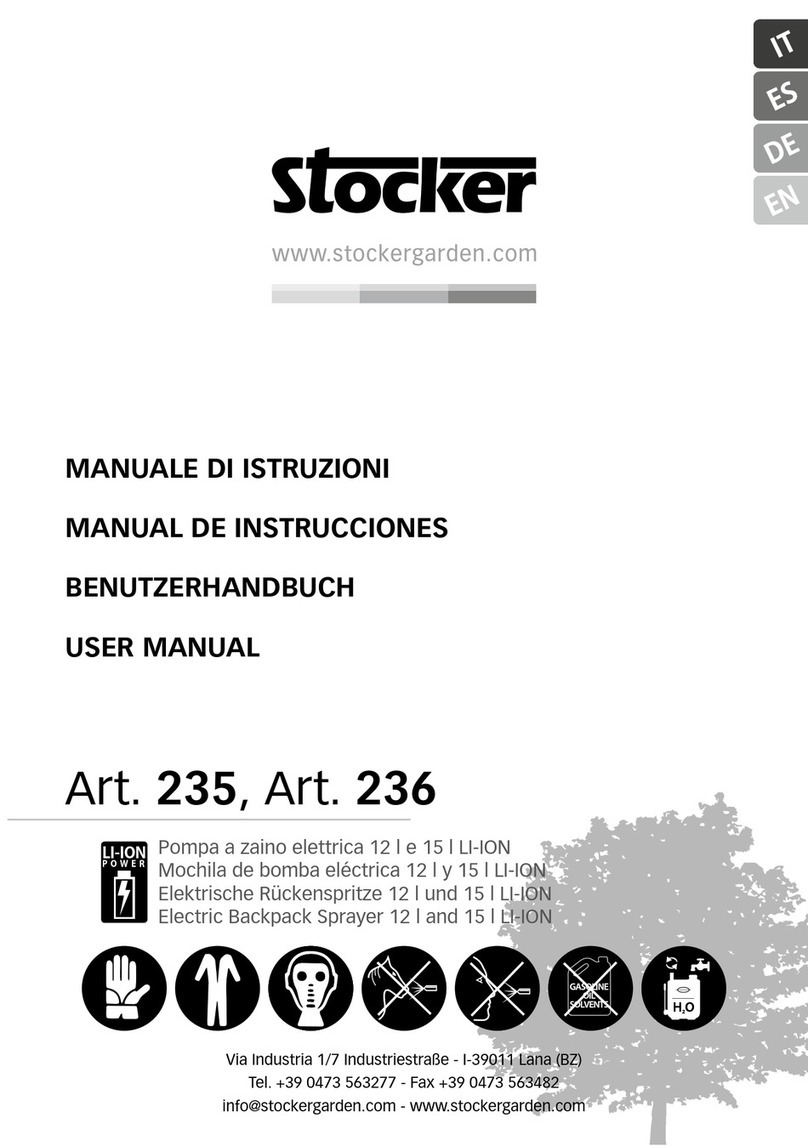
Stocker
Stocker 235 user manual

Titan
Titan IMPACT 1640 operating manual
